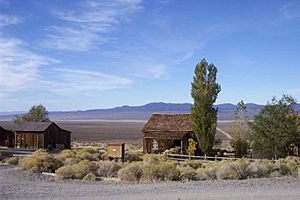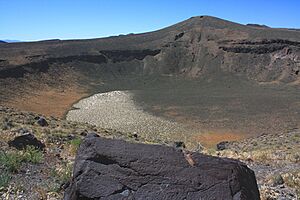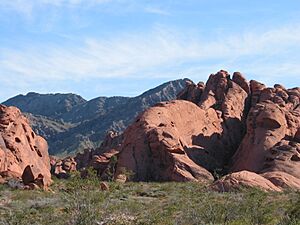List of National Natural Landmarks in Nevada facts for kids
Nevada is a state in the western United States. It is known for its deserts, mountains, and famous cities like Las Vegas. But did you know Nevada also has some very special natural places? These are called National Natural Landmarks. They are chosen because they show important parts of Earth's natural history. There are six of these amazing spots in Nevada.
Contents
Nevada's Special Natural Places
National Natural Landmarks are like natural treasures. They are protected because they have unique plants, animals, rocks, or landforms. They help us learn about how our planet works. Let's explore Nevada's six special natural landmarks!
Berlin–Ichthyosaur State Park
This park is in Nye County. It became a National Natural Landmark in 1973. Imagine finding fossils of huge sea creatures in the middle of a desert! This park is home to the remains of 37 giant Ichthyosaurs. These were ancient marine reptiles, like big fish-lizards, that lived millions of years ago. It's an amazing place to see what Earth was like long ago.
Hot Creek Springs and Marsh
Located in Nye County, this area was named a landmark in 1972. It is a very important spring and wetland. A wetland is a marshy area where water is always present. This special place provides a home for a rare fish called the White River springfish. This fish is a "relic," meaning it's a survivor from a time when the area had more water.
Lunar Crater
Lunar Crater is also in Nye County and became a landmark in 1973. It's called "Lunar" because it looks a bit like a crater on the Moon! This 400-acre area is a "maar." A maar is a wide, flat-bottomed volcanic crater. Scientists think it was formed by a powerful volcanic explosion in the past. It's a cool example of how volcanoes can shape the land.
Ruby Lake National Wildlife Refuge
This refuge is in Elko County. It was named a landmark in 1972. Ruby Lake is one of the biggest and best natural wetlands in Nevada. It's a vital spot for many kinds of birds and other wildlife. It's a peaceful place where nature thrives, especially for migrating birds.
Timber Mountain Caldera
Found in Nye County, this landmark was designated in 1973. A "caldera" is a large, bowl-shaped hollow. It forms when the ground collapses after a volcanic eruption. Timber Mountain Caldera is what's left of a huge ancient volcano. It was active millions of years ago, during the late Miocene and early Pliocene periods. It shows us the powerful forces that shaped Nevada's landscape.
Valley of Fire
This amazing state park is in Clark County. It became a landmark in 1968. Valley of Fire is famous for its bright red sandstone formations. These rocks look like they are on fire when the sun shines on them! It's a great example of "thrust faulting." This is when huge blocks of Earth's crust slide over each other. It creates incredible rock shapes and patterns.





